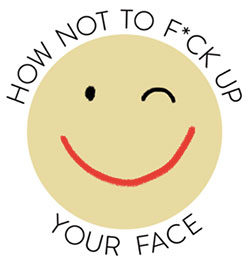By Valerie Monroe
If you’re interested in feeling happier about your appearance—especially as you age—you might like reading what she has to say about it. For more of her philosophical and practical advice, subscribe for free to How Not to F*ck Up Your Face at valeriemonroe.substack.com.
THERE WAS a story in The Atlantic some months back that coincides with a point I’ve made here early and often. In his “How to Build a Life” column, Arthur Brooks discusses the implications of self-objectification. I’ve written about the way self-objectification relates to how not to f*ck up your face—and I’m bringing it up again because it’s important to something that’s important to me: your happiness.
From the time we first look at ourselves in a mirror, we (girls, mostly) are encouraged to see our faces as something—thing being critical here—to be manipulated in order to please an outside observer, likely the male gaze. In that way, we learn to objectify our face and—to telescope a somewhat complex process into a fine point—disassociate our personhood from our reflection. Here’s what Brooks says about one of the consequences of self-objectification:
Seeing yourself as an object rather than a subject can . . . lower your performance in ordinary tasks. Researchers have found in learning experiments that people are less likely to try new things when they are focused on themselves.
And on the subject of mirrors:
. . . mirrors are not your friend. They help even the healthiest people objectify themselves; for people with self-image-related maladies, they can be sheer misery. In 2001, researchers studying people with body dysmorphic disorder (those who think obsessively about perceived flaws in their bodies) found that the longest time the participants spent looking in the mirror (and thus focusing on the source of their distress) was 3.4 times longer than the longest mirror-gazing session of those who didn’t have the disorder.
Though Brooks suggests we simply eschew mirrors—an idea far more practical (if not socially rewarding) for a 58-year-old man than for most of us—we can learn to look at our reflection in a way that nourishes rather than starves our self-esteem. It’s called mirror meditation, and you can read about it here. After you’ve read about it, Just Do It. Then, Just Do It again. And again, till you actually see the person who lives behind your face.
You’ll find a great benefit of not seeing yourself as an object to be admired (or criticized!) is that it allows you to become an active gazer rather than a passive gazed-at. What does this mean? It means becoming engaged with the world in a new way. This, for me, was one of the brilliant results of becoming a looker rather than only a looked-at. To start with the basics, you may have noticed already that our eyes are a magician’s trick (though if you’re like me, think too long about how eyes work and your head will explode). A wonderment, no? This brings me to another of Brooks’s points:
In his research, the UC Berkeley psychologist Dacher Keltner focuses on the experience of awe, which he defines as “the feeling of being in the presence of something vast that transcends your understanding of the world.” Among its many benefits, Keltner has found, awe diminishes the sense of self. For example, in one study, he and his colleagues asked people to consider either an experience in nature that was very beautiful or a time when they felt pride. Those who thought about nature were twice as likely as those who thought about pride to say that they felt small or insignificant, and nearly a third more likely to say that they felt the presence of something greater than themselves.
If you came here just to learn about skincare, treatments, and procedures, I want to point out to you that this information might be useful to you, too—maybe even vital. Because you’re a lot less likely to want to fiddle with your face when your face is in front of, say, the Grand Canyon, or Walden Pond, or these Fabergé Imperial eggs. I thought of the eggs because when I find myself unhappy with the face I now have, unwillingly decorated with the influences of age, I hightail it over to the art museum near my home. There, instead of looking at my old grown-ass face, I look at the magnificent 19th-century Fabergé eggs, or the ancient studly Greek statues, or the portraits of people, so alive-looking, who now exist only in a remarkable arrangement of pigment.
I always feel better when I leave the museum, as if the beauty of the stuff has seeped into me, commingled with my blood, and made me beautiful, too. And in a way it has, the way taking a deep breath oxygenates you, with its attendant happy effects on your nervous system.
You don’t live near a museum? You can discover loveliness right where you are. Often on a walk, I find the music I’m listening to so perfectly synthesized with what I happen to be looking at that it feels like some kind of miracle. Which of course, in our awareness and ability to appreciate it, it is. The poet Mary Oliver put it this way:
. . . I don’t know exactly what a prayer is.
I do know how to pay attention, how to fall down
into the grass, how to kneel in the grass,
how to be idle and blessed, how to stroll through the fields
which is what I have been doing all day.
Tell me, what else should I have done?
Doesn’t everything die at last, and too soon?
Tell me, what is it you plan to do
With your one wild and precious life?
You could lift your face to the sky.
A quick word about retinoids, the vitamin A derivatives I mentioned in a recent post. Doctors have told me noncompliance is one of the biggest problems with patients using a retinoid. Because it can initially irritate the skin, many people stop using it before they see any benefit, which can take up to six months. That’s why it’s important to use only a pea-size amount and to ease into it, starting once a week and gradually increasing usage. Another point an astute reader brought up is that the prescription-strength drugstore retinoid gel I use these days is marketed for acne treatment. That’s right, but the retinoid—adapalene—offers the same benefits as other prescription retinoids. I happen to like a gel rather than a creamier formulation. As always, if you have questions about your skincare, write to me at valeriemonroe@substack.com.
MyLittleBird often includes links to products we write about. Our editorial choices are made independently; nonetheless, a purchase made through such a link can sometimes result in MyLittleBird receiving a commission on the sale, whether through a retailer, an online store or Amazon.com.
If this post was sent to you by a friend, you can sign up for the newsletter at the very, very bottom of this page.



Cynthia, thanks for sharing your response to the post; it’s very meaningful to me that you found it helpful and I’m with you on the challenge of moving the needle from disappointment to neutral to self-love. But it is so worth the effort. xo
Maureen, I’m glad you enjoyed the post. And Mary Oliver’s poetry, as you discovered, can be a great balm. I hope you continue to feel less blue. xo
Thanks for a great story. Lately I have felt a little down and my daughter gave me a copy of “Devotions” — a collection of Mary Oliver poetry. Reading it made me feel much better.
Val-
Great post- the psychological argument for grounding oneself in nature is solid. As for a mirror-less lifestyle, basic good grooming is a hallmark of a solid, healthy and balanced ego. We can’t stop time but we can transform our minds as we age and mirror gazing is a powerful tool. I understand that there is a fine line between self-acceptance and self-obsession, but perhaps that’s reflected in how one FEELS about what we SEE when we look in the mirror. I’m working hard to keep moving that needle from disappointment to neutral to self-love. It’s a journey, but articles like this one help tremendously.
Thank you